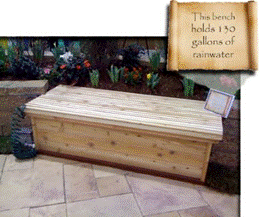
A rain barrel is a very simple way to reduce runoff on your property. When placed under a downspout, it collects the water that drains off the roof, via gutters. Not only can this reduce erosion and sedimentation on your property, but since the water in the barrel can be used to water your plants or gardens, it also reduces water consumption.
The main limitation of the rain barrel is its capacity. The average rain barrel can hold 55 gallons, which is the approximate amount of water produced by one inch of rain falling on a ten foot by ten foot area or 100 square feet of roof. Numerous rain barrels can be used for a single roof by placing one at each downspout. If a single barrel is not enough to accommodate the water from a downspout, you may equip the barrel with an overflow hose to redirect the excess, or connect multiple barrels with hoses to increase their capacity.
A rain bench is a similar concept, but stores the water in a large plastic bladder inside a wooden bench structure. The bladder has a 65-gallon capacity, but you can use two bladders, for example, and simply double the size of the bench. With large houses, though, you may want to consider a larger-scale, landscape solution.
In order to determine the rain barrel or bench capacity necessary to capture the runoff from your roof, calculate the area (in square feet) of your roof that drains to each downspout, and divide that number by 100 (the number of square feet of roof that can be drained to a single rain barrel or bench). Note: roof area is simply a measure of horizontal length and width; there is no need to take the slope of the roof into account in measuring roof area.

Rain barrels are often made by reusing 55-gallon plastic drums; this is an easy and inexpensive do-it-yourself project. Rain barrels can be purchased online or from commercial retailers in more decorative styles. Costs usually vary from 80 to 200 dollars. For the rain bench, each do-it-yourself kit costs 70 dollars, and the lumber costs an additional 30. A double capacity rain bench would cost about 200 dollars.
